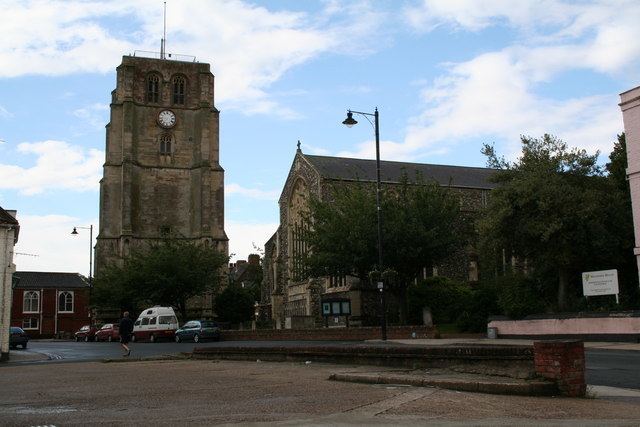Construction started c1500 Height 30 m Phone +44 1502 712109 | Completed 1540 Opened 1540 | |
 | ||
Hours Closed today WednesdayClosedThursdayClosedFridayClosedSaturday10:30AM–4:30PMSundayClosedMondayClosedTuesdayClosed Architectural styles English Gothic architecture, Perpendicular Style Similar Beccles Lido, Beccles railway station, River Waveney, Coronation Chair, Africa Alive! | ||
The Beccles bell tower is a free-standing Grade I listed edifice associated with the adjacent St. Michael's church in the market town of Beccles, Suffolk, England.
It stands near the edge of a cliff overlooking the River Waveney, the bell tower rises an additional 97 feet (29.6 m) and is thirty feet square (9m) at its base. It dominates the town as well as the surrounding countryside, much of which is comprised by The Broads National Park. Views of the Waveney, the North Sea on the eastern horizon, and the flat terrain of the broads extending south into Suffolk and, across the river, into nearby Norfolk, can be obtained by scaling the hundred steps to the top of the tower.
Construction started around 1500, under the direction of the monks of the Abbey of St Edmundsbury, the important pilgrimage destination in the nearby town of Bury St. Edmunds. Like the main body of St. Michael's church, the tower is Perpendicular Gothic in style. The tower is supported by deep foundations, very thick walls faced with Roche Abbey stone (so called because of its use in the now-ruined abbey near Maltby, South Yorkshire), and huge buttresses; there is a neweled staircase at each corner of the tower.
It is customary for bell towers (also called campanile) to be built at the western end of a church, the end opposite the altar. However, the site at Beccles, near the edge of a cliff, and the enormous weight of the proposed tower, approximately three thousand tons, dictated that the tower be built to the east of the church as a free-standing structure. Local historians believe that the tower was originally intended to have a steeple and spire but after forty years of construction, the Protestant Reformation during the reign of King Henry VIII (and the suppression of Roman Catholic institutions) intervened to bring work to a halt.
Great skill and care is evident in the tower's construction, particularly in the tracery and the ornamental niches and panels of the stonework. The tower entrance is similar to the south porch (portico) of the church; it features the coats of arms of local families who contributed substantially to the project. These families include the Garneys, the Redes, and the Bowes.
The interior of St. Michael's was badly damaged by fire in 1586, but the tower was unaffected.
Early in the eighteenth century, two clock faces were affixed to the north and south sides of the tower, and, a century later, another was added to the east side and all three were raised to a slightly higher level. At present the clock is run by electricity and controlled by computer, allowing the twice-yearly change between Greenwich Mean Time and British Summer Time to be made quickly. The tower bells sound on each quarter-hour and ring out the time on the hour, stopping at 8pm to allow town residents some peace and quiet during the night.
Originally there was a ring of eight bells, but this was replaced, in 1762, by Lester & Packe of Whitechapel Bell Foundry, London, with a ring of ten bells. In 1909 all ten bells were completely restored by Taylors Eayre & Smith Ltd (Loughborough) and re-hung on a new steel frame. The ringing chamber is on the second level of the tower, and the belfry is on the fourth.
One of the most historically significant events associated with this church and bell tower is the wedding, in 1749, of Catherine Suckling and the Reverend Edmund Nelson, the parents of England's seafaring hero, Lord Horatio Nelson.
